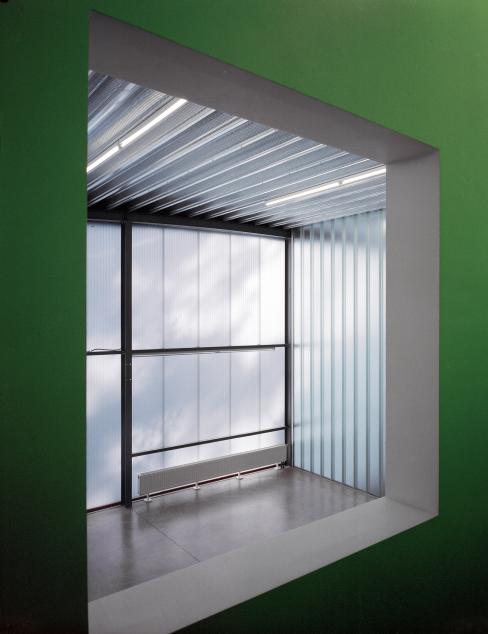Description
The Centre for Group Dynamics and Institutional Analysis (CDGAI) is a benchmark in French-speaking Belgium in the field of "psychosocial science-action". Dethier Architectures was chosen to design new infrastructures for the Centre. The project began in March 2002 and was completed in February 2004.
The new building was erected in the Sart-Tilman science park in Liège. It is very much is in line with the site's urban planning philosophy, which calls for high-quality architecture in harmony with a cherished wooded landscape.
A simple but demanding project
The CDGAI welcomes small groups working in the area of social psychology, and was designed as a place where individuals can gather and exchange. As the meeting rooms need to be set off from the outside world, translucent walls provide ample light. The building's organisation is clear-cut and provides a high degree of flexibility for interaction. It consists of a single-storey rectangular structure (23m x 10m) with a mezzanine. The ground floor houses two meeting rooms and their annex as well as the entryway, a secretariat, a kitchen, a room for office equipment, lavatories and a machine room. Offices and a library are located on the mezzanine. To keep costs down, we fit the various parts into a small volume with a curving roof that underscores the protective atmosphere within. A masonry façade on the north side provides bracing, while the south façade consists of a steel framework. A roof wraps over the entire structure, extending down to the ground.
Innovative materials
Budgetary concerns also led to the innovative use of high-quality materials normally reserved for industrial use. Black rubber was used as a roof covering and for the eaves. The ceilings reveal the perforated, galvanised sandwich steel that supports the roof. Translucent glass and polycarbonate panels provide both soundproofing and diffuse natural light. In addition, Reglit was employed for the partitions and OSB panels, and polished reinforced concrete was used for the flooring slabs.
Economical and environmentally friendly solutions
The choice of easy-to-install materials allowed us to keep costs down and limit the environmental impact. Customised digital technology, using computerised drawings for the creation of the prefabricated elements, made it possible to achieve a flush fit between the walls and the metal framework on the south façade, and ensure the evenness of the sandwich steel roof (no time wasted with on-site adjustments). The emphasis on savings was also extended to maintenance costs. The system for evacuating rainwater is an example of this – the roof is devoid of cornices that could be blocked by falling leaves, and rainwater is collected at ground level in two easy-to-clean gutters. Rather than install an expensive air conditioning unit, we opted for a free cooling system for adjusting the building's temperature. At night, screened vents allow cool air to be absorbed by the masonry and the cement flooring, which is then given off slowly during the day. It is important to note that cost-consciousness can have environmentally friendly repercussions, such as the direct ground absorption of rainwater and the preservation of the existing topography and vegetation, ensuring that the structure fits well into its natural surroundings. By emphasising the technical and aesthetic qualities of industrial materials, the CDGAI is able to combine rationalism, innovation and sustainable development.
A thoughtful approach
Our approach, which juxtaposes volume and lightness, is particularly evident when one compares the masonry wall of the north façade and the metal framework of the south façade. The sheltering appearance of the former dialogues with the openness to nature of the latter, which is enlivened by the play of light and shadows of the trees on the polycarbonate. The elegant interaction between solids and voids diffuses light in a variety of ways. By day, the large rooms are filled with abundant natural light, while at night the building is transformed into a sort of lantern. Artist Jean Glibert chose to focus on this luminous intensity, using the sheen of the galvanised roof to reflect the green and red tones of the office and the library towards the reception area and meeting rooms. The interaction of light and contrasts finds an echo in the wooded area in which the structure rests, in the Sart-Tilman science park. A laboratory for social interactions by day and a lantern by night, the building conforms to the landscape while simultaneously clearly asserting its visual identity.
Technical sheet
Construction of an office building with meeting rooms.
Localization
Longitude: 5° 33' 24.263" E





















